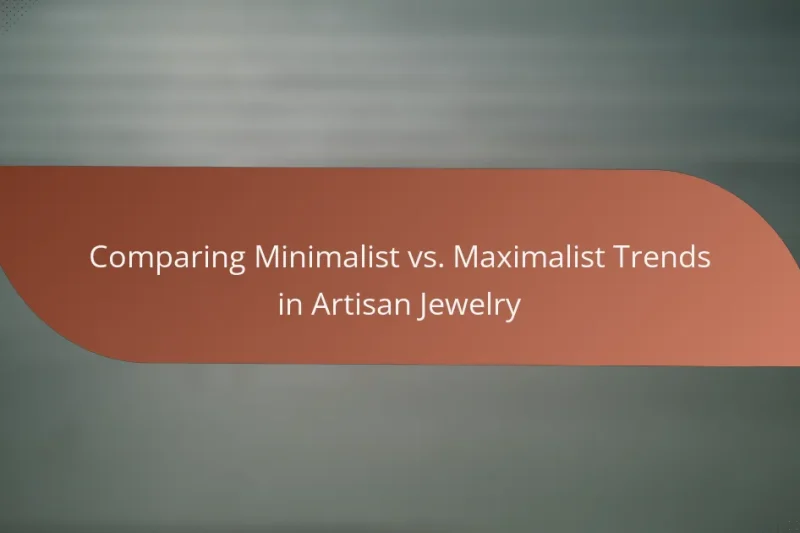The influence of nature on current artisan jewelry designs is profound, as it provides a rich … The Influence of Nature on Current Artisan Jewelry DesignsRead more
Trends in Artisan Jewelry Design
Artisan jewelry design is currently characterized by a focus on unique, handcrafted pieces that embody personal style and sustainable practices. With an emphasis on creativity and individuality, these trends reflect a deep connection to nature and the materials used, while also prioritizing environmentally friendly methods and ethical sourcing.
How Cultural Influences Shape Artisan Jewelry Design Trends
Cultural influences play a pivotal role in shaping artisan jewelry design trends, reflecting the rich diversity … How Cultural Influences Shape Artisan Jewelry Design TrendsRead more
Understanding Seasonal Trends in Artisan Jewelry Collections
Understanding seasonal trends is crucial for artisan jewelry makers, as these trends drive consumer demand and … Understanding Seasonal Trends in Artisan Jewelry CollectionsRead more
How to Incorporate Vintage Design Trends into Modern Artisan Jewelry
Incorporating vintage design trends into modern artisan jewelry can significantly elevate its aesthetic and emotional value. … How to Incorporate Vintage Design Trends into Modern Artisan JewelryRead more
Comparing Minimalist vs. Maximalist Trends in Artisan Jewelry
In the world of artisan jewelry, minimalist and maximalist trends showcase two contrasting design philosophies. Minimalist … Comparing Minimalist vs. Maximalist Trends in Artisan JewelryRead more
Top 2025 Trends in Artisan Jewelry for Fashion Enthusiasts
As we look ahead to 2025, artisan jewelry trends are set to highlight individuality, sustainability, and … Top 2025 Trends in Artisan Jewelry for Fashion EnthusiastsRead more
The Role of Technology in Evolving Artisan Jewelry Designs
Technology is revolutionizing the world of artisan jewelry design, providing artisans with tools that enhance creativity, … The Role of Technology in Evolving Artisan Jewelry DesignsRead more
What are the current trends in artisan jewelry design?
Current trends in artisan jewelry design focus on unique, handcrafted pieces that reflect personal style and sustainable practices. These trends emphasize creativity, individuality, and a connection to nature and materials.
Nature-inspired designs
Nature-inspired designs draw from the beauty of the natural world, incorporating elements like leaves, flowers, and organic shapes. Artisans often use materials that mimic natural textures, such as wood or stone, to create a harmonious connection with the environment.
These designs can evoke feelings of tranquility and appreciation for the outdoors, making them popular among consumers seeking to express their love for nature through jewelry. Consider pieces that feature intricate floral motifs or earthy color palettes for a truly organic look.
Minimalist aesthetics
Minimalist aesthetics focus on simplicity and clean lines, often utilizing geometric shapes and subtle details. This trend appeals to those who prefer understated elegance, allowing the craftsmanship to shine without overwhelming embellishments.
When selecting minimalist jewelry, look for pieces that use high-quality materials like sterling silver or gold, as these can elevate the overall appearance. A single, well-crafted ring or a pair of delicate earrings can make a significant impact without being overly flashy.
Upcycled materials
Upcycled materials are gaining traction in artisan jewelry design as sustainability becomes a priority for many consumers. Artisans creatively repurpose discarded items, such as vintage jewelry or scrap metal, to create new, unique pieces that tell a story.
This trend not only reduces waste but also offers a distinctive look that mass-produced jewelry cannot replicate. When choosing upcycled jewelry, consider the craftsmanship and the narrative behind the materials to appreciate the artistry involved.
Personalized pieces
Personalized pieces allow wearers to express their individuality through custom designs, often featuring initials, names, or significant dates. This trend caters to those looking for meaningful gifts or unique self-expression.
Artisans may offer engraving services or customizable options, enabling customers to create one-of-a-kind jewelry that resonates on a personal level. Consider opting for a piece that reflects a special memory or milestone for a truly personal touch.
Bold colors and textures
Bold colors and textures are making a statement in artisan jewelry, with vibrant gemstones and mixed materials taking center stage. This trend encourages experimentation and allows wearers to showcase their personality through eye-catching designs.
When selecting pieces with bold colors, consider how they complement your wardrobe. Textured finishes, such as hammered metal or woven fabrics, can add depth and interest, making even simple designs stand out.
How is sustainability influencing artisan jewelry?
Sustainability is significantly shaping artisan jewelry by prioritizing environmentally friendly practices and ethical sourcing. This shift encourages designers to adopt methods that minimize ecological impact while promoting social responsibility.
Use of ethically sourced materials
Artisan jewelers are increasingly using ethically sourced materials to ensure their creations do not contribute to environmental degradation or human rights violations. Common materials include recycled metals, conflict-free gemstones, and sustainably harvested wood. By choosing these options, artisans can appeal to conscious consumers who value transparency and responsibility.
For example, many jewelers now provide certification or documentation proving the ethical origins of their materials. This practice not only builds trust with customers but also aligns with growing market demand for sustainable products.
Eco-friendly production methods
Eco-friendly production methods are becoming standard in artisan jewelry design, focusing on reducing waste and energy consumption. Techniques such as handcrafting, using solar-powered tools, and minimizing water usage are gaining traction. These methods help artisans lower their carbon footprint while maintaining high-quality craftsmanship.
Additionally, some artisans are adopting innovative practices like 3D printing, which can reduce material waste significantly compared to traditional methods. By implementing these eco-friendly approaches, jewelers can create beautiful pieces that resonate with environmentally conscious consumers.
What are popular techniques in artisan jewelry making?
Popular techniques in artisan jewelry making include hand engraving, metal smithing, and stone setting. Each technique requires specific skills and tools, allowing artisans to create unique and intricate designs that reflect their personal style and craftsmanship.
Hand engraving
Hand engraving involves carving designs into metal surfaces using specialized tools. This technique allows artisans to create detailed patterns, initials, or images that enhance the aesthetic appeal of the jewelry. It is often used for personalizing pieces, making them more meaningful to the wearer.
When considering hand engraving, artisans should choose the right metal, as softer metals like silver are easier to engrave than harder ones like platinum. Additionally, the depth and intricacy of the engraving can affect the durability of the design, so careful planning is essential.
Metal smithing
Metal smithing is the process of shaping and joining metal to create jewelry. This technique includes various methods such as forging, soldering, and casting, allowing for a wide range of designs and styles. Artisans often work with metals like gold, silver, and copper, each offering unique properties and finishes.
For successful metal smithing, artisans should invest in quality tools and practice essential skills like measuring and cutting accurately. Understanding the properties of different metals is crucial, as it influences the techniques used and the final appearance of the piece.
Stone setting
Stone setting is the technique of securely placing gemstones into jewelry pieces. This process can involve various methods, including prong, bezel, and pave settings, each providing different aesthetics and levels of security for the stones. Proper stone setting enhances the overall design and protects the stones from damage.
When setting stones, artisans must consider the type of stone and its hardness, as softer stones may require more protective settings. Additionally, ensuring a snug fit is vital to prevent stones from loosening over time. Regular checks and maintenance can help preserve the integrity of the setting and the beauty of the stones.
Which artisan jewelry brands are leading the market?
Several artisan jewelry brands are at the forefront of the market, known for their unique designs and commitment to craftsmanship. Brands like Catbird, Mejuri, and Alex and Ani have gained significant popularity, each offering distinct styles and philosophies that resonate with consumers.
Catbird
Catbird is renowned for its handcrafted jewelry made in Brooklyn, New York. The brand focuses on ethically sourced materials, including recycled gold and conflict-free diamonds, appealing to environmentally conscious consumers.
With a strong emphasis on personalization, Catbird offers custom pieces that allow customers to express their individuality. Their signature engagement rings and delicate everyday jewelry are particularly popular among millennials and Gen Z shoppers.
Mejuri
Mejuri has carved a niche in the direct-to-consumer jewelry market, emphasizing fine jewelry at accessible prices. The brand operates on a transparent pricing model, which eliminates traditional markups and allows customers to purchase high-quality pieces without overspending.
Mejuri’s approach includes a focus on everyday wear, offering minimalist designs that can be layered or worn alone. Their limited-edition collections and collaborations with artists keep the offerings fresh and appealing to a fashion-forward audience.
Alex and Ani
Alex and Ani is recognized for its eco-conscious jewelry, often featuring symbolic designs that promote positivity and empowerment. The brand’s signature expandable wire bangles are customizable, allowing customers to choose charms that reflect their personal beliefs and milestones.
With a strong community focus, Alex and Ani often engages in charitable initiatives, donating a portion of sales to various causes. This commitment to social responsibility resonates with consumers looking for meaningful purchases that contribute to a greater good.
How to choose artisan jewelry for special occasions?
Choosing artisan jewelry for special occasions involves understanding the recipient’s personal style and the nature of the event. Consider the uniqueness of artisan pieces, which often reflect craftsmanship and individuality, making them ideal for memorable moments.
Consider the recipient’s style
When selecting artisan jewelry, it’s essential to consider the recipient’s personal style. Look for pieces that align with their preferences, whether they favor bold statement items or subtle, delicate designs. For example, a recipient who enjoys bohemian fashion might appreciate handcrafted pieces featuring natural stones and organic shapes.
To ensure the jewelry resonates, pay attention to their existing accessories. If they often wear gold, consider artisan pieces in similar hues, or if they prefer silver, seek out unique silver designs. This alignment will enhance the likelihood that they will cherish the gift.
Evaluate the occasion’s formality
The formality of the occasion significantly influences your choice of artisan jewelry. For formal events like weddings or galas, opt for elegant pieces that complement sophisticated attire. Think of refined necklaces or earrings that add a touch of glamour without overwhelming the outfit.
Conversely, for casual gatherings or everyday wear, artisan jewelry can be more playful and relaxed. Consider colorful beaded bracelets or whimsical pendants that reflect the laid-back nature of the event. Always aim for a balance between the jewelry and the occasion to ensure the recipient feels comfortable and stylish.
What are the pricing factors in artisan jewelry?
Pricing for artisan jewelry is influenced by several key factors including materials, craftsmanship, design complexity, and market demand. Understanding these elements can help both creators and buyers navigate the artisan jewelry landscape effectively.
Materials Used
The choice of materials significantly impacts the price of artisan jewelry. Precious metals like gold and silver, along with gemstones, tend to increase costs due to their inherent value. For instance, a piece made with sterling silver may range from $50 to $200, while gold pieces can start in the low hundreds and go up significantly based on weight and purity.
Craftsmanship and Labor
Artisan jewelry often reflects a high level of craftsmanship, which can add to its price. The time and skill required to create each piece are critical factors. For example, intricate designs that involve hand-setting stones or detailed metalwork may take several hours to complete, justifying higher prices, often in the range of $100 to $500 or more depending on the complexity.
Design Complexity
Unique and complex designs can command higher prices in the artisan jewelry market. Pieces that feature custom designs or innovative techniques often appeal to buyers seeking exclusivity. For example, a custom-designed ring might range from $300 to $1,000, depending on the intricacy of the design and the materials used.
Market Demand and Trends
Market demand plays a crucial role in pricing artisan jewelry. Trends can shift based on consumer preferences, seasonal styles, or cultural influences. For instance, during holiday seasons, prices may increase due to higher demand, while off-peak times might see discounts or lower pricing strategies to attract buyers.






